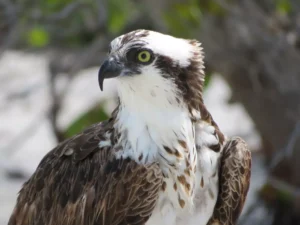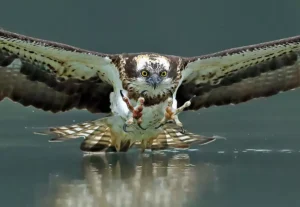Osprey is one of the most magnificent birds of prey. They have a wingspan of up to six feet and can dive at speeds of over 100 miles per hour. Osprey lives along coastlines and rivers, where they hunt fish.
These amazing predators are now in danger because of the use of DDT. DDT is a pesticide that was once widely used to control mosquitoes and other insects. DDT does not break down easily in the environment and can accumulate in the food chain.
When osprey eats fish that have been exposed to DDT, it can cause them to lay thin-shelled eggs that break during incubation. This has caused osprey populations to decline sharply in some areas.
DDT is a harmful pesticide that has been banned in the United States since 1972. However, it is still used in other countries and can be transported to the U.S. through migration.
Osprey is particularly vulnerable to DDT because they eat fish that may have been exposed to the pesticide.
DDT can cause health problems for osprey, including reduced reproductive success and increased mortality.

Why is DDT Especially Harmful to Birds?
DDT (dichlorodiphenyltrichloroethane) is an insecticide that was first synthesized in 1874. It wasn’t until the 1940s that DDT’s insecticidal properties were discovered, and it became widely used during World War II to control malaria and typhus among troops.
After the war, DDT was made available for civilian use and its use skyrocketed.
In 1962, Rachel Carson’s book Silent Spring brought public attention to the harmful environmental effects of DDT, and its use began to decline.
Despite being banned or restricted in many countries, DDT is still used in some parts of the world because it is inexpensive and effective at killing insects. However, DDT is also highly toxic to birds.
Birds are particularly vulnerable to DDT because it accumulates in their bodies over time.
When birds eat insects that have been exposed to DDT, the pesticide builds up in their tissues and can eventually reach levels that are lethal.
Additionally, DDT interferes with calcium metabolism in birds, which can lead to thinner eggshells that are more likely to break before the chicks hatch.
Studies have shown that even small amounts of DDT can cause reproductive problems in birds, including decreased fertility and reduced hatching success.
The long-term effects of DDT on bird populations are still not fully understood but there is no doubt that this pesticide has had a devastating impact on many species of birds around the world.
Why is DDT Harmful to Wildlife?
DDT (dichloro diphenyl trichloroethane) is a colorless, tasteless, and almost odorless pesticide. It was first synthesized in 1874, but its insecticidal properties were not recognized until 1939.
DDT was used extensively during World War II to control malaria and typhus among civilians and troops.
After the war, DDT became the key ingredient in many agricultural and residential pest control programs.
However, by the 1960s scientists began to realize that DDT was accumulating in the environment and having harmful effects on wildlife, particularly birds.
Birds are harmed by DDT in two ways: direct poisoning and thinning of eggshells.
When birds eat insects that have been sprayed with DDT, the poison accumulates in their bodies. This can lead to tremors, convulsions, paralysis, and death.
In addition, DDT interferes with calcium metabolism in birds, causing thinning of eggshells.
As a result, bird populations declined sharply after widespread use of DDT began in the 1940s. The Bald Eagle is one of the most well-known victims of DDT poisoning.
By 1963 there were only 417 nesting pairs left in the contiguous United States; today there are more than 10 times that number thanks to a ban on DDT use that went into effect in 1972.
However, Bald Eagles are still exposed to high levels of DDTs due to contaminated runoff from agricultural fields where the pesticide has been used historically; as a result, they continue to experience reproductive problems such as thinning eggshells.

How Much Ddt Does an Osprey Have?
According to the Environmental Protection Agency, ospreys have been found to have high levels of DDT in their bodies.
The amount of DDT that an osprey has depends on a number of factors, including where they live, what they eat, and how long they live.
For example, ospreys that live in areas where DDT is still being used may have higher levels of the chemical in their bodies than those that live in areas where it has been banned.
Ospreys that eat fish that have been exposed to DDT may also have higher levels of the chemical in their bodies than those that do not eat contaminated fish.
Why is Ddt Harmful to Bald Eagles?
Bald eagles are one of the many species of birds that are adversely affected by DDT. When DDT enters the environment, it eventually makes its way into waterways, where it is ingested by fish.
The fish are then eaten by bald eagles and other predators, causing them to suffer from a condition known as eggshell thinning.
This can lead to reproductive failure in birds, as well as a number of other health problems.
Biomagnification and the Trouble with Toxins
Why is Ddt Harmful to Osprey Quizlet?
DDT is harmful to osprey because it is a persistent organic pollutant. DDT accumulates in the food chain and can reach levels that are toxic to osprey.
Studies have shown that DDT exposure can cause reproductive problems in osprey, including reduced egg production and hatching success.
Conclusion
DDT is a harmful pesticide that was once commonly used to kill mosquitoes and other pests. However, it has since been banned in many countries due to its harmful effects on the environment.
One of the most significant effects of DDT is its impact on osprey populations.
Ospreys are a type of bird that eats fish almost exclusively. Due to their diet, they are particularly vulnerable to DDT contamination. When ddt enters the food chain, it accumulates in the fatty tissues of animals like ospreys.
This can lead to a number of issues for the birds, including reduced reproduction rates and decreased survival rates for young chicks.
There have been some efforts to reduce DDT use in recent years, but it still remains a problem in many parts of the world. If we want to protect ospreys and other wildlife from the harmful effects of this pesticide, we need to continue working to reduce its use and release into the environment.